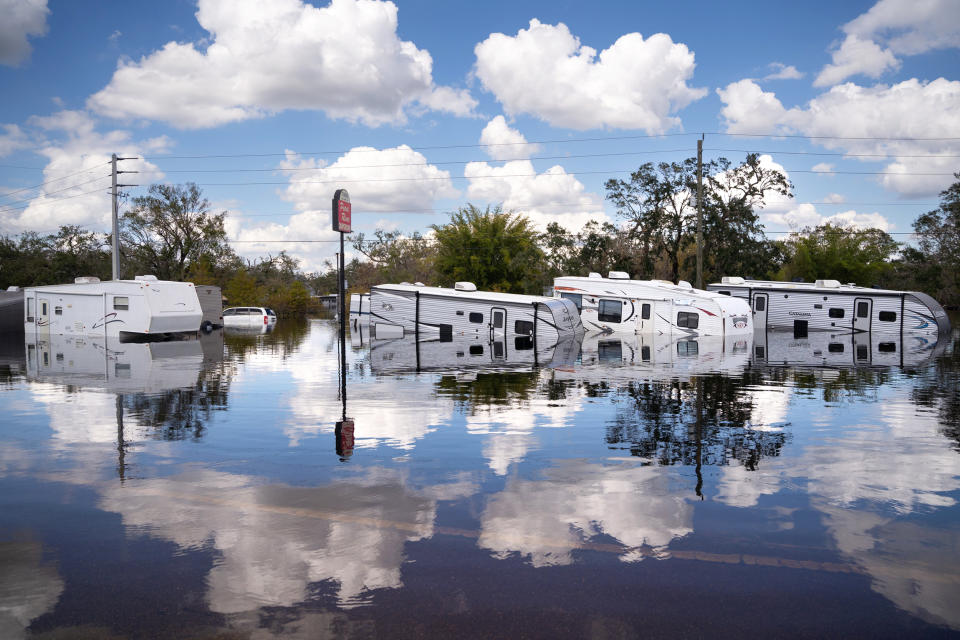Latino families, some of them climate refugees, found a home in southwest Florida. Ian took it all away.
The water slipped in through the walls first, before there was a loud boom and it came spilling into the bedrooms of Jennifer Rosa Rivera’s apartment around 3 a.m. as Hurricane Ian ravaged Florida.
Rosa Rivera, 31, and her partner, Guillermo Cuero, faced a difficult choice when it came to protecting their 8-month-old baby, 9-year-old daughter and 8-year-old son. Should they stay or risk fleeing into the black waters surrounding their apartment complex in Kissimmee, in Osceola County?
By the time the water had reached their knees and kept coming, the children began to panic. Cuero swaddled their infant close to his chest while Rosa Rivera held on to her two other children as they fled in the early hours of Sept. 29, finally finding refuge at a neighbor’s house on higher ground. Rosa Rivera said her son had asked her, “Mama, are we going to die?”

The family lost nearly all of its possessions, including two cars that were submerged up to their windows. The apartment for low-income families that Rivera has been renting in Kissimmee is in need of major repairs that will take months.
Her children, all of whom survived, now ask her: “Mama, where are we going to sleep tonight?”
Hurricane Ian devastated parts of southwest and central Florida where Latino growth has been rapid, leaving some communities with nothing but questions about what to do next — finding new housing, getting back to work, finding food and how to begin again. For many families, life in Florida was an escape from other climate disasters or extreme violence and poverty.
Losing everything — again
Cuero headed to Florida after Hurricane Maria tore through Puerto Rico in 2017, ultimately killing nearly 3,000 people and leaving many on the island without power for months or up to a year.
“He lost absolutely everything,” Rosa Rivera said. Cuero moved to the mainland U.S. “starting from zero," she said.
Now he and his family have to start over again.
More than 101 deaths have been blamed on Ian, which made landfall in southwest Florida as a Category 4 hurricane on Sept. 28, bringing a devastating storm surge as high as 14 feet and relentless 150 mph winds. Ian is the second-deadliest storm to hit the U.S. mainland this century, behind Hurricane Katrina in 2005.
“As the days go by, we continue to learn about more heartbreaking stories in our communities,” said Laudi Campo, the Florida state director of the Hispanic Federation, which is providing assistance to a number of counties with large Latino populations, including Broward, Collier, Hillsborough, Osceola and Volusia.
In hard-hit Lee and Collier counties, nearly 1 out of every 4 residents is Hispanic, up from about 1 in 5 in 2010.
Many in Osceola County, where Rosa Rivera’s family lives, have called the federation, saying “they lost everything, not because of wind but because of floods,” Campo said.
From 2010 to 2021, the county’s Latino population grew from around 45.7 % to around 56.3 %.
Campo said the full impact of the damage Latinos in the area face is still unknown. The federation is still waiting to hear from some communities as water remains too high to go in to provide aid.
Some of the most vulnerable also remain “in the shadows,” Campo said, reluctant to come forward because of fears about their immigration status.
In DeSoto County, which is about 32 % Latino, the hurricane led to massive flooding as the Peace River spilled over, even though the county is 50 miles from the Gulf Coast.
“What we’ve gone through in the days since the storm has been horrible,” said Juan Velásquez, 45, whose neighborhood in Arcadia is home to mostly Latinos. Velásquez, who is from El Salvador, had been without power and water for five days when he spoke to NBC News on Thursday.

Velásquez said the water rose by 2 feet outside his home, trapping his family members inside. They provided shelter for some neighbors who lived in a nearby trailer.
Using buckets and other tools, they tried desperately to remove water from the home as it poured in through the sides of doors.
The storm cut off parts of the community, where a major road opened up earlier on Thursday. But stores remain empty, and residents have to drive at least an hour to get food or medicine, Velásquez said.
Velásquez said that troops have started to move into the area and distribute food and water but that many Latino families remain fearful and concerned.
“People are frustrated because they fear that help will come too slowly,” he said. Some undocumented members of the community, he said, may be too scared to go to official locations for aid.
Many remain traumatized by Hurricane Ian’s destruction around them.
“These are one of those things that no one wishes to live through. The anguish. These are the things that mark you for life,” he said.
Follow NBC Latino on Facebook, Twitter and Instagram.
This article was originally published on NBCNews.com
